


I am so disgusting, I feel sorry for everyone on this bus. My last shower opportunity was four sweaty backpacking days ago, and now I’m on a bus bumping through Bolivia for the next 24 hours. I started to wonder why I hadn’t made any friends on this bus, as I pride myself on being able to make friends anywhere in any situation. Then I realized it was because I smelled like a dog’s balls.
We stopped off in Copacabana on the shores of Lake Titicaca and I treated myself to a very weird Bolivian vegan lunch of avocado-filled taco shells and a shopping spree for the three things I instantly lose every time I leave my home: sunglasses, chapstick and nail clippers. I have bought these three items in every country on Earth, thus fulfilling my role as a critical lynchpin in the global economy.
My filthy nails clipped, we were onto a boat and off to Isla Del Sol, the spiritual birthplace of the Inca people and the home of the Sun God. I celebrated this profound fact upon landing on the island by sprinting off the boat to find a place to pee. I found a baño and had just conducted my business when I suddenly realized there was no water whatsoever inside the toilet. Uh-oh. This is like that trip to Home Depot we don’t talk about.
There was no one around, so I decided I had no choice by to leave this gift for the gods and carry on with the hike. Stepping out the front door, some guy started yelling at me that I needed to pay for peeing in a Bolivian Home Depot. I explained that there was no water, which is where I draw the line on places I’ll pay to take a whiz. He led me back inside and showed me a big tub of water on the floor, and mimed washing his hands in it.
Oh hell no. Okay wait, there are some plastic scoops here. They look like milk jugs cut in half diagonally. I can scoop water out of the bucket into my hands over the sink? I guess I can deal with this. But if I’m going to pay for this whole experience I’m gonna get my money’s worth. After struggling to figure out how to say “toilet paper” in Spanish (papel higienico!), I had some papel in hand and entered the second stall (some inconsiderate asshole had peed in the first one and just left it there), thinking that first toilet must have been broken. I took care of the second half of my business there, noting mid-business that there was no water in this toilet either. Hrmm.
I washed my hands, paid the dude his Boliviano, felt sorry for him that he had to deal with whatever was going on with those waterless toilets, and took off to hike the island.
Two days later I would encounter a similar bathroom deep in the salt flats of Uyuni in southern Bolivia. There were far more people malodorously present in that nightmarish white salt bathroom, and I realized watching them that you were supposed to scoop the water out of that big tub and dump it into the toilet, not onto your hands, to flush your cares away. Oh shit. Literally.
Sorry Isla Del Sol guy. In my defense I hardly ever go into someone’s place of business, soil two toilets and then just leave. Hardly ever.
Up the hill from the Home Depot there were Bolivian women sitting on the path who were selling random bullshit on blankets. My favorite of these scenes featured a woman paying absolutely no attention to the tourists hiking by her blanket of crap while she played Candy Crush on her phone. The majestic hillsides sat silently as BODOOP! BLEEDEEP! CHING CHING CHING!
My least favorite were all the women who loudly implored me to pay them so I could take a picture with their children. This was balanced somewhat by the absolutely adorable baby alpacas they had running around. I really wanted a photo of those alpacas but didn’t think I had enough Bolivianos to cover their appearance fee.
The energy on Isla Del Sol had an interesting buzz to it, though I wrestled with uncertainty about whether I was really tuning into some ancient Incan spirituality, or was just out of my mind because I had not had legitimate sleep in seven days.
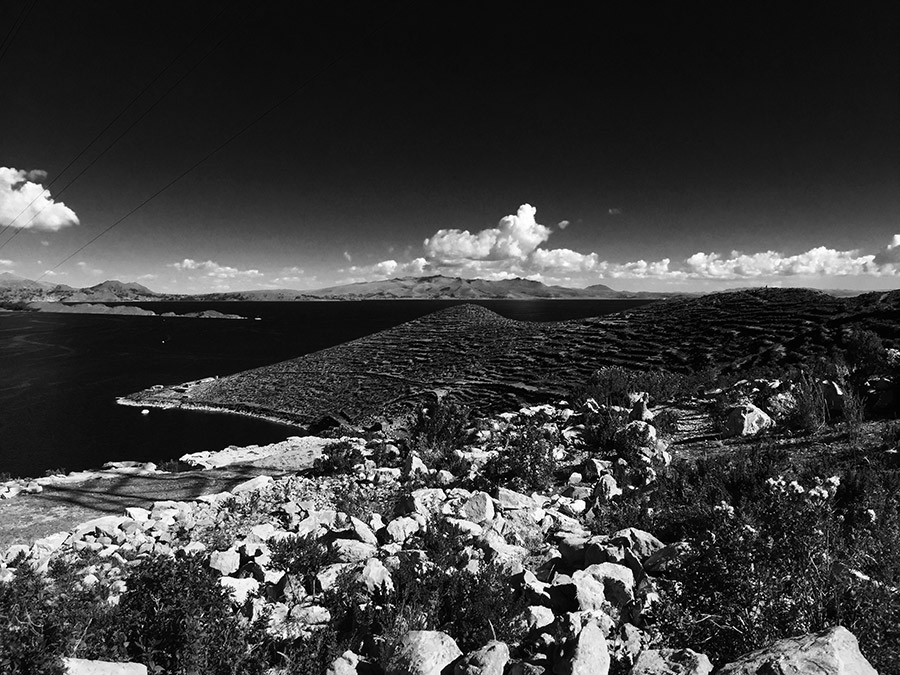





The real kick in the nuts about Isla Del Sol is that you can only visit part of the island, due to some kind of conflict between the native tribes in the north and the south. I figured this was fine, the south half was enough for me. But the south “half” is actually just the southern coastline, and all of the interesting spiritual sites are on the northern nine-tenths of the island. I made up for this by getting totally lost and wandering around up in the hills and talking to llamas until I realized my boat was about to leave and I had to sprint down the mountain and through the entire town like a goddamned maniac. For those scoring at home, this was Sean’s second time on the trip sprinting down a mountain while a bunch of people waited impatiently and almost left without him at the bottom. Stay tuned for number three!


Back on the mainland, our bus carried on, past a brain-melting Bolivian sunset that looked like ho-hum nothing in all of the 400 photographs I took of it, until we reached the point that night where the bus had to cross Lake Titicaca. This involved all of us getting off the bus and boarding a cramped ferry, while the bus rolled onto an impossibly janky barge that dipped down at the front end until it was nearly taking on water, then slowly and precariously crossed the entire lake that way.
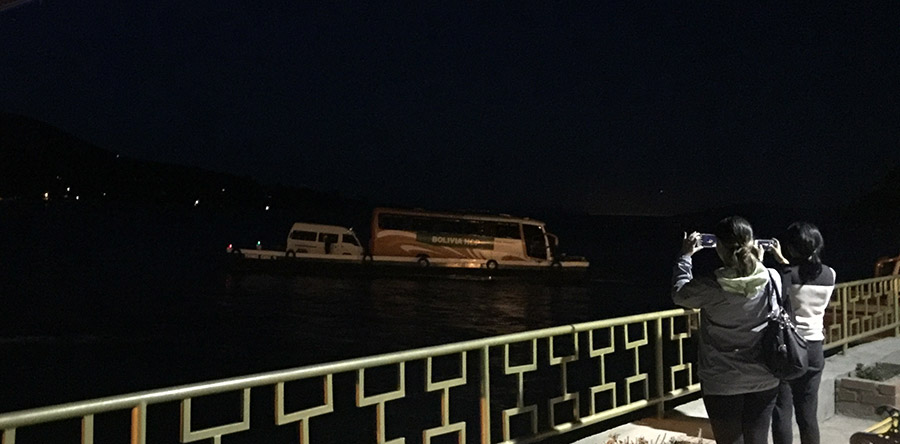
In time, the lights of La Paz spilled out across the black hillsides all around us, and I finally got the shower the entire world had been begging me to take all week.

North Yungas Road in Bolivia earned the title of the World’s Most Dangerous Road after an Inter-American Development Bank study in 1995 determined that more people had died on that road than any other road on Earth. Due to the fact that the road is just a narrow groove carved into a cliff face, with no safety railing, in a foggy jungle, two to three hundred people a year were missing turns and falling off the cliffs to their deaths every year. Finally in 2006, a new road was built bypassing this hair-raising route. Nowadays the traffic on the old road is mostly thrill seekers on mountain bikes. Some of them die too, though not quite at the rate that the car drivers were pulling it off.
Our group of six was a German couple, a Brazilian couple, an Australian guy and me. Rest assured I got to know all these folks, but I’m terrible with names. Go read somebody else’s blog if you’re only in this for the names.
After the long drive from La Paz, we reached the starting point for the ride and the German girl bailed immediately. Okay, so we’re down to five.
Far down below us, a bus that went off the cliff sat tiny and crumpled on the rocks below, like a dead caterpillar.

The road snaked around the mountains all around us as we gulped in the thin air.


The opening ceremony inaugurating our six hours of death roading fun involved taking a little bottle of pure alcohol, pouring it over your front tire, and taking a small sip so that it won't hurt when your soul leaves your body as it hits the rocks at the bottom of one of the road's jagged cliffs.

We got a good overview of our snazzy bikes and death road etiquette and we were off down the few miles of “easy” paved road before the death road proper begins.

There are good and bad times to suddenly realize you haven’t been on a bicycle in 15 years. Barreling down a steep mountain in Bolivia at dizzying speeds is one of the bad times. You might think it would be comforting to find yourself on a $3,000 downhill racing bike at this moment, but in actuality it’s like realizing you can’t drive while you’re behind the wheel of a Lamborghini and all the cops are chasing you.
The bike’s handlebars turned when you looked at them, and the slightest movement of any part of my body would cause the bike to swerve. These traits and responsiveness are, I’m sure, fantastic if you know what you’re doing. But if you’re flying down a mountain so fast the tires are making a sound you’ve never heard before, and you have about a foot of space to work with between the gravely edge of the road and the point at which cars flying down the mountain will clip you going by, the last thing you want is to realize desperately that you can’t keep the bike straight and are wobbling like a duck shot out of a cannon.

Add onto the mix that you’re riding with hard core mountain biking enthusiasts who can ride without touching their handlebars, while they’re taking carefully composed photos with both hands. And they’ve all flown by you in a blur while you were trying to figure out the right combination of front and rear brakes to stop wobbling without throwing yourself over the handlebars or fishtailing frantically off the side of the mountain.
Also, you’re at 15,000 feet and you can’t breathe.
This situation did, however, offer two saving graces. One was the absolutely breathtaking scenery. Clouds wrapped around the stark mountains dreamily as we flew by. The valley below stretched on endlessly into the distance. If you’re wondering why I don’t have more photos of this, please see every last thing I wrote above about what I was doing at this moment instead of taking photos.

We passed through an unattended police checkpoint, there to search cars for the precursors for cocaine production, which is a weird thing to fly through on a bike. Every few miles we’d all pull over for a check in, and during these, first one, then two of our riders had to get flat tires repaired due to thumb tacks left in the road. Our guide suggested they’d been put there by pissed off coca farmers in the area. Yeah thanks, this was another variable I definitely needed.
The second saving grace was that the Brazilian guy’s girlfriend was riding with us and she had no idea what she was doing either. There’s so much comfort in not being the slowest one in the group, even if “slow” still means “about to die at all times” and “faster than 99% of people have ever traveled without a windshield.”
This particular comfort was short-lived. After I got done shitting my pants, we left the first checkpoint and took off down the mountain again, a bit faster this time as the decline increased. Our guide Tim had warned us about the copious potholes and huge bumps coming up in the next section of road, which were added in since this would all be far too easy otherwise.

So now I’m slaloming down the road, trying not to swing far enough left to be killed by one of Bolivia’s terrible drivers, some of whom honked a polite warning as they passed, others of whom preferred “Surprise, motherfucker!” levity. I’m actually not sure which version I preferred, since every time someone honked unexpectedly from two feet behind me, every muscle in my body would tense up and I’d nearly fly off the mountain in a rigor mortis pose.
I had passed the section of the road that, as our guide aptly described, looked like a bomb had gone off, leaving you a tire-wide strip of safe asphalt to cross at the edge of the carnage. Whew. Picking up speed as I flew downhill, I heard the Brazilian girl approach from behind. Wow, is she really going pass me? Good for her, she must be figuring this out- Then I heard a hellacious squeal of brakes and glanced back over my shoulder just in time to see her go over her handlebars. This was followed by the sickening sound of her body hitting the ground and tumbling and skidding head over heels down the road.
I jammed on the brakes and ran back up the hill to see if she was okay. The support van following us was already there and they were checking on her. Long story short, she must have done some kind of master judo fall because she only seemed to have banged up her knee and was quickly up and walking around. I wouldn’t have been surprised at all if she were dead, so this was a massive improvement on expectations. Since she’d landed on her head, they sent her to the hospital to check for a concussion and her boyfriend went with her. And just like that, we were down to three.

Oh, and yeah, we rode the death road in the rain and fog. They were going to release some Bengal tigers to make it even more difficult but we didn’t pay enough for that extra.
Probably the cruelest quirk of the death road is that you have to ride on the cliff side of the road. Everywhere else in Bolivia you drive on the right side of the road, but on the death road you drive on the left instead, which gives drivers a better view of where the cliff edge is. Bikes follow the same rules. The road’s not really wide enough for left/right to be that far apart, but if you’re worried about falling off the cliff to your death, never being more than a couple of feet from the edge at any time probably wouldn’t be your first choice. Nor would needing to move even closer to the edge every time an oncoming car goes by.
We headed off down the death road proper and I did my best not to defecate voluminously every time a large rock kicked out my back tire three feet to one side or the rain runoff steered my bike toward the cliff edge with no input from me. Just before we reached the start of the gravel road, we’d ridden on a rough, rocky detour bypassing a tunnel on the paved road, at which point I began to feel that I was in way over my head. Large rocks were pitching my bike at strange angles and kicking the wheels out from under me unpredictably in random directions. Oh Jesus. I decided that very slowly was the only way I was going to be able to navigate this section. So I touched the brakes and was immediately thrown forward over my handlebars.
Whatever my other skill deficiencies, I seem to have pretty strong instincts in moments like this, be it blindly grabbing vegetation while sliding down a cliff face in Hawaii or wedging myself between two rock faces during a fall while climbing in Nevada as a teenager. I jumped off from the pedals and threw my feet as far forward as I could, ahead of the handlebars, and landed on them instead of my face. I awkwardly came to a skidding stop on my feet, with the bike akimbo between my legs. Whew.
As we bombed down the loose gravel, gripping our handlebars for dear life, the road was dotted with crosses and memorials along the edge, commemorating the many, many, many places a car had gone off into the abyss.
The biggest thing I’d underestimated about the ride, other than the fact that I’d completely forgotten how to ride a bike in the last decade and a half, was that a gravel road in South America is not like a gravel road in North America. I had imagined an American-style gravel road, relatively smooth dirt with small, uniformly-sized rocks spread across it. The actual death road was more like one part that and fifteen parts fresh landslide. More than once I had my handlebars violently yanked completely out of my hands by the rough terrain, which is in no way dismaying when you’re racing down a mountain. There’s probably a special level of embarrassment that comes from losing your front teeth because you hit your face on your own handlebars.

I rode the first section of the death road with my brakes on 100% of the time, which you can only hold up for so long before your hands tell you to F off. As the day went on I rode faster and faster, which I’d like to think was due to my confidence growing, but in all honesty my hands were just too destroyed to squeeze the brakes any more.
At one of the check-in stops we got to talk to one of the other groups doing the ride. One guy in that group had a bandage across his broken nose, a heavily wrapped left elbow, and bandages all over his right hand and all his fingers. The more nervous riders were wearing full face motocross helmets, which offered the Catch 22 of protecting your face better if you landed on it, at the cost of reduced peripheral vision and not being able to hear people yell that they’re passing you, thereby increasing the chances that you will crash and land on your face.
Shortly before that stop I actually passed a few people, which made me feel a million percent better about not being able to keep up with the maniacs in my crew. Once we stopped for lunch and the slowpokes I’d passed caught up with us, I realized it was the mother and daughter from Israel I’d met on the bus from Peru to Bolivia the day before. We’d noticed then that we had an eerily similar itinerary for our days in Bolivia, and I’d joked that I’d see them on the death road. And here we were! They next day I ran into them again in a tiny town on the way to the salt flats in Uyuni, so either these were crazy coincidences or they were supposed to tell me I’m dead and I need to accept it already and stop avoiding that weird little boy who keeps showing up at my house.
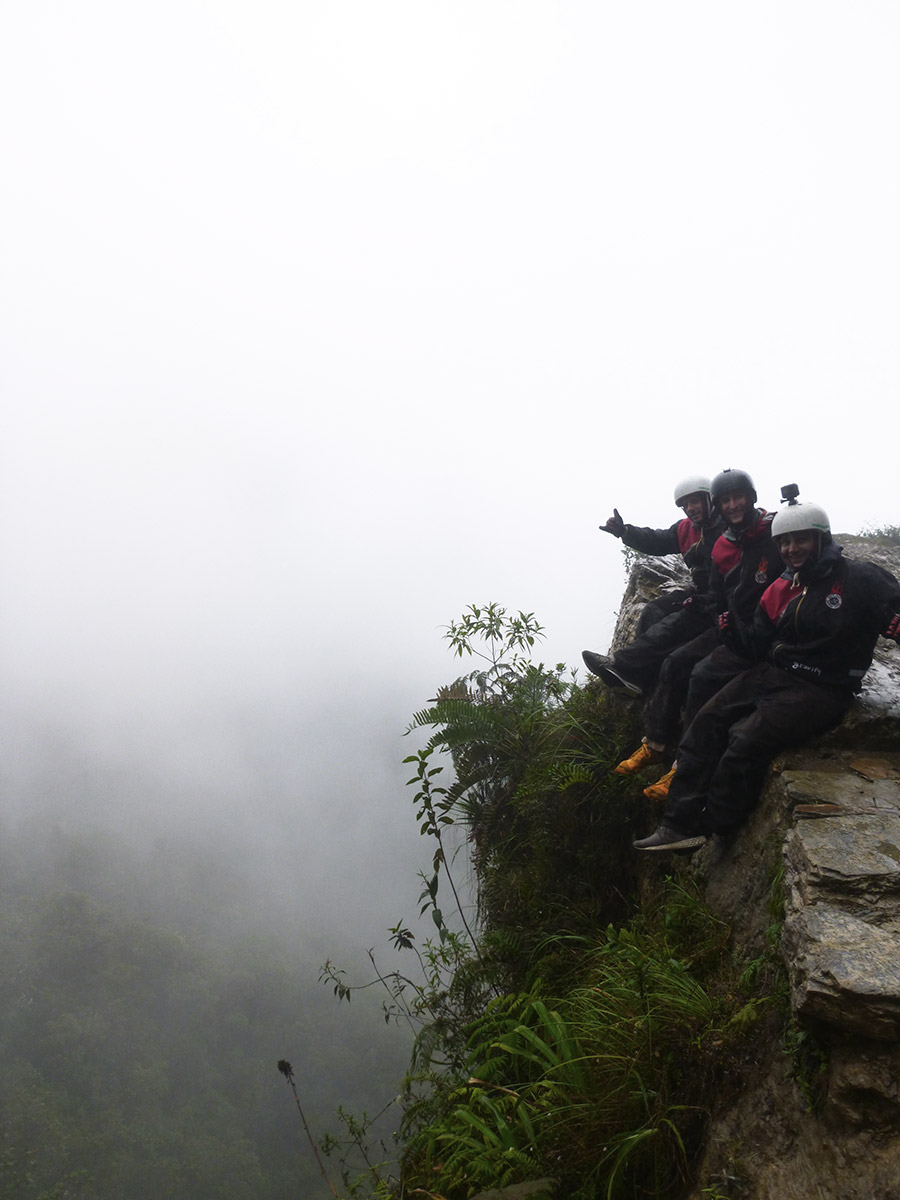

Sometime after this on the death road, we started riding through waterfalls, which, sure, that’s fine. My German friend ate shit going around a corner near this point, and attained his official death road souvenir scar on his elbow.
Toward the end of the ride we rode through a series of rivers, after being primed with the warning that we’d be fine- as long as we weren’t going too slow when we hit the water. Great. I made it through the first one without incident, aside from getting soaking wet. This can apparently be avoided by putting your feet up on the handlebars as you zing through the water, like our guide did, but this is the developmental equivalent of a baby winning the NBA slam dunk contest, while I was still lying face-first on the kitchen floor, sucking a spaghetti sauce stain off the linoleum.
At the last river, our second guide was set up to take photos of us being awesome crossing the river, and I promptly displayed my awesomeness by having a wet river rock kick out my back tire mid-stream, causing me to very nearly fall on my face in the middle of the river. Instead, I shot my legs off the bike awkwardly to one side and regained my balance, then wobbled the rest of the way through the river and hoped our guide didn’t get a photo of me looking like an octopus trying to ride a motorcycle.
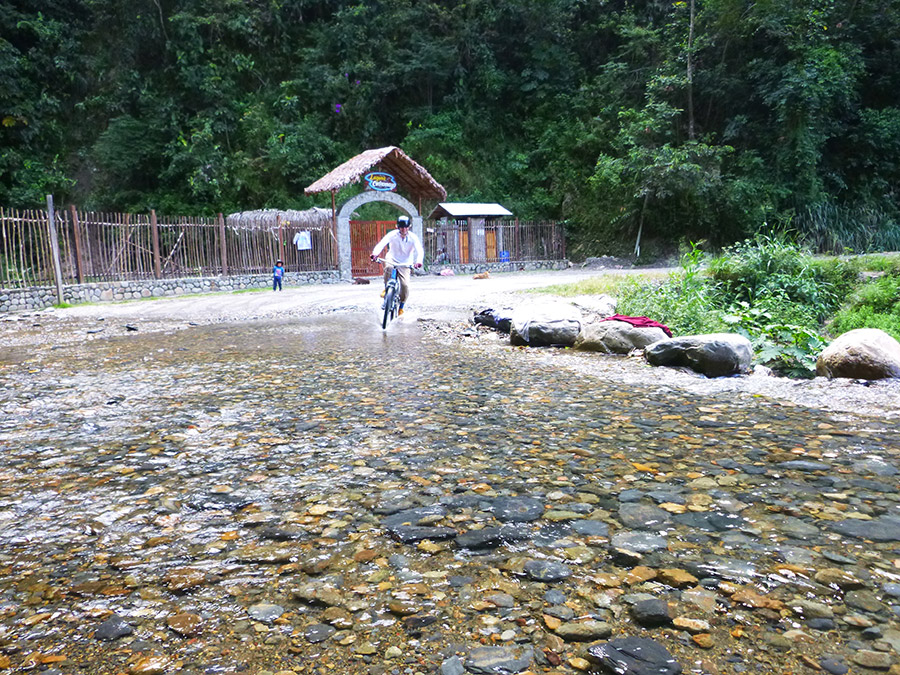
As we entered the village at the end of the road, the ride turned into the video game Paperboy, with dogs wandering out into the road, trucks bearing down unexpectedly, and little kids doing little kid things. We’d been warned that the children in the village liked to high-five the riders as they passed by, but that you high-fived at your own risk since in two recent instances, a kid had grabbed onto a rider’s arm mid-high-five and pulled them off their bike. As I’ve always said, kids are assholes.
After reaching the end of the ride in the village, somehow still alive, we were nonsensically offered the opportunity to ride a zip line across the valley. This was probably the time in my life when I was least in need of a shot of adrenaline, but it looked fun and when was I going to be back here again? My German friend was all thrilled out and my Aussie friend wasn’t a big fan of heights, so quickly I found myself alone in a little office, getting fitted into a harness with a huge bib on the front, like I was about to get dental x-rays of my everything.
I finished signing away my lawsuit rights and specifying who should get the stuff in my pockets after I die, then was led to a pickup truck parked across the street. The truck had a dramatically shattered windshield and some kind of metal pipes welded over the bed. My zip-line Sherpa gestured for me to get into the back of the truck. The back? Okay. I put my foot into a rusted metal rung hanging off the back of the tailgate and stepped up into the truck bed. I guess we’re going to sit here and- oh, we’re standing! The truck took off as I awkwardly wrapped my elbows around one of the pipes and attempted to drop neither my phone nor my bottle of water, my pockets now completely covered by assorted ziplining apparatus.

We headed back up the road I had just ridden down minutes before, as I fumbled with trying to find a spot in my ziplining rig to stuff my bottle of water so I could use a hand to hold onto the bar better as we went around corners. All of my pockets were covered by the bib, but I eventually managed to stuff the bottle into my back pocket and held on as we bump bump bumped up the road.
It was interesting to see the death road from a car’s perspective, as bike riders swerved and wobbled frantically to get onto the left side of the road before we obliterated them. Just a few minutes ago I had been one of those people, sailing down the hill thinking “Okay, I think I’ve got this, just keep your weight back andOH FUCK A TRUCK!” Those maniac truck drivers! Now the perspective was flipped and the maniacs were on bikes.
Part way up the hill we pulled off up another road and stopped. I climbed down out of the truck, which pulled away without a word. My Sherpa and I hiked up a series of muddy switchbacks up the mountainside to the start of the zipline.

You’re given the option of riding the zipline in the traditional position (picture yourself in a seated position hanging from a rope) or in the Superman position (picture Superman hanging from a rope). I, of course, chose the Batman position, but they didn’t have the cartridges for the grappling hook gun so I had to settle for Superman. This worked similarly to the zipline I did in the UK a few years back, where they clip the back of your harness to the cable and you walk forward on your hands until you’re suspended from the cable. In the UK I’d had to wear a cape (honestly, they didn’t have to work very hard to talk me into this) to keep me from going too fast and crashing face-first into the opposing cliff like Wile E. Coyote. In the Bolivian setup there’s no cape and your Sherpa actually rides behind you, so you can wave and scream “OH GOD FUCK PLEASE SLOW IT DOWN” if you need him to god fuck slow it down.

The other difference from the UK is that Bolivia has no safety standards whatsoever.

“Okay?” my Sherpa asked.
“O-” I began to say and suddenly the brake disengaged and I was flying face-first off a cliff. The first twenty feet of the zipline are you with your face about three inches off the ground, flying along to the top of the cliff, then some kind of plant hit me in the cheek and we were sailing off into the open air.
This is, of course, completely thrilling. Your heart swells as the valley below zips by and you excitedly look around in all directions to take in the sensation. I’m not sure if anything else feels this close to flying. Skydiving feels like falling, and I’ve never been hang gliding but I imagine being higher up and moving more slowly, you might feel a little bit less like a badass bird up there.
I succeeded in not face-planting into the opposite cliff and we were ready for zipline #2.

The first zipline is the highest, the second is the fastest and the third is the longest. Clip clip, awkwardly getting yourself parallel to the ground, and zing, hovering a few inches off the ground and praying you don’t dip any lower and that no taller rocks have snuck into the mix since the last time somebody did this, before you’re flung off another cliff. This one was indeed the fastest, the sound of the pulley on the cable above me rising in pitch as we raced down the line and my shadow screamed across the valley below me. I never asked my Sherpa to slow down, both because I didn’t want to and because I don’t know how to say “slow down” in Spanish.
On the opposite cliff I got my feet under me and stood up right into the cable for the second time in a row. BONK. What a klutz- oh well, this guy probably sees that kind of thing all day. Maybe.
I hope I’m not the first person to ever ride this zipline.
I asked the Sherpa to wait a minute while I got my phone out and took a few photos of the cable and the scenery around us. He completely misinterpreted my statement as meaning I wanted to hold my phone and film the next zipline ride. “Sure, camera!” he said. Holy shit, I can just hold my phone? The zipline in the UK had secured my phone into an elaborate clamshell and a harness bolted onto my helmet for a fee so I could record that ride, but Bolivia is way more chill than that. You want to hold your phone up while you haul ass down this cable, probably dropping it on someone in the town below as soon as the wind inevitably knocks it out of your hands? Sure, whatever gringo. That’s so Bolivia.

The third ride was fun, though it was highly distracting trying to death grip my phone to keep from losing it as we flew along and I pointed it at all the things we were flying over.
The best part of this is that my phone, clearly terrified, stopped recording five seconds into the ride.
After reaching the bottom, the janked-up truck returned and gave me a lift over to the wild animal refuge where my fellow death roaders were hanging out.

Not having any idea of when to quit, we signed up for a tour to see the rescued spectacle bears they had living up in the wooded hills of the refuge. Before we entered the fenced-in area, our guide asked us to remove everything we had on us: glasses, phones, wallets, everything, so that the monkeys wouldn’t steal them. I wasn’t sure about leaving all my stuff on a table in this random place in Bolivia while we went for a hike. She pointed at my necklace “If you like that, I wouldn’t take it with you.” “I’ll just put it in my pocket.” “The monkeys will go through your pockets. They can open zippers.” “I thought we were going on a bear tour, why are we going to get mugged by monkeys?” “If you try to resist, they will bite you.” Okay then.
On the way to the bear habitat we saw toucans and tortoises and a tapir, mixed in with dogs and cats and three quarters of a barrel of monkeys. All the animals here had been saved from poachers, or were drug dealers’ pets, or had been tied up in a village and beaten with a stick by the locals. Bolivian law prohibited them from ever being returned to the wild, so their lot in life was to hang out here and mug tourists.
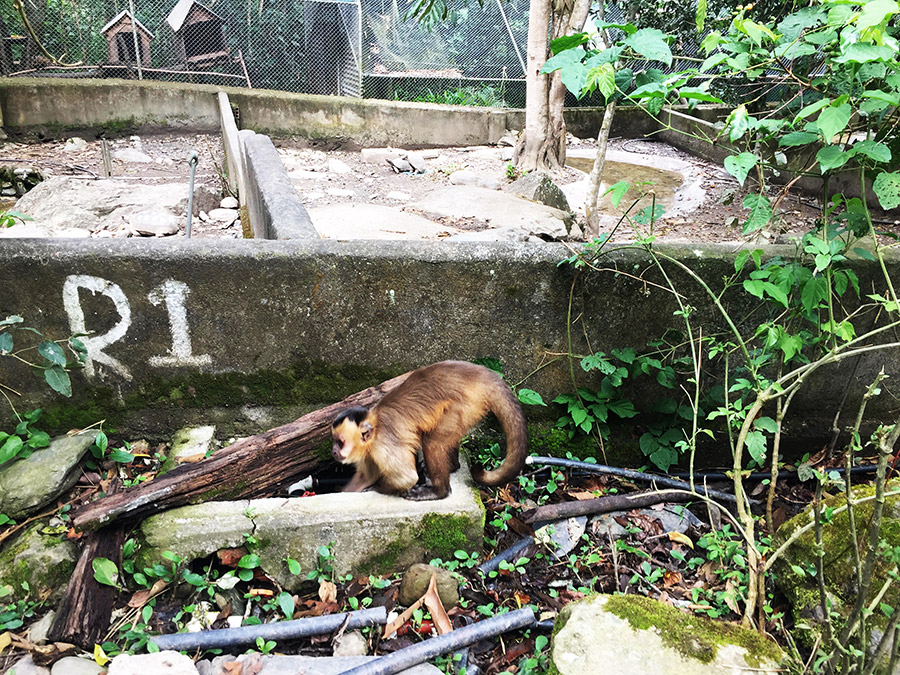

At the end of the trail, we waited, and as if on cue, the spectacle bears came to check us out. These were gentle and adorable bears that were really into eating alfalfa.
And yes, I do mean that annoying kid from The Little Rascals. Good riddance.

Leaving the animal refuge, we picked up two zookeeping students from Denmark who needed a ride to La Paz for the weekend, and we all rode together through the fog for hours back to the city. At one point we stopped in a village to get a hole in our spare tire patched, which they did with some kind of homemade glue from a repurposed water bottle. They also had this impressive sink:

Rolling through the preposterously dense fog in the night, I realized how ironic it would be to die in a crash on the way home from the World’s Most Dangerous Road. I looked out through the windshield. Man, I can’t see shit. I hope the driver can see more shit than I can. He furiously wiped condensation away from the inside of the windshield with a t-shirt. I looked around for a seat belt. Nope. I was sitting in a little seat that folded down out of the proper seats like a beach chair. I’m sure this thing wouldn’t snap off and send me zinging through the windshield in the slightest fender bender.
That seems to be one of the great ironies of travel. At home, I’d never ride in a car without a seat belt, yet on a seriously sketchy road in a sketchy vehicle in a sketchy country during sketchy weather, there’s never one available.
The hours passed as I talked to our guide Tim about the Vipassana meditation retreat I’d done, which he wanted to try as well. An alarming number of ambulances flew past us in the fog. At one point traffic backed up behind a bus that was sideways on the road ahead. Three Bolivian men were pushing on the front of the bus while a Bolivian woman pushed on the side of the bus, seemingly at cross purposes with everyone else. We made a joke about physics not making it to Bolivia yet. It appeared that they were trying to push the bus while it was still in gear, so it was just rocking back and forth.
I got out with the guides to see if we could do anything to help. It turned out the bus had a broken drive axle and after some milling around we decided we didn’t have one of these and got back in our van, joining the conga line of cars inching off the road to drive around the bus.
In time we made it back to La Paz and I was dropped off. It’s so strange to do these trips and to make all these new friends of limited duration. Traveling with people for a week seems to be long enough to form a bond where you’ll keep in touch after the trip, anything shorter becomes dicey. One day is definitely too short. I said my goodbyes and hiked up the hill to my hotel.

My alarm went off at F-you thirty, it was time to go to Uyuni. I realized the shoes I’d hung up to dry in the bathroom had pissed some unthinkable brownish-orange residue all down the bathroom wall, and there was no time at all to fuck with this. I added a few more Bolivianos to my tip stack for the maids and lit out for El Alto. My taxi to the highest international airport in the world had what appeared to be a bat in a plastic bag hanging from the rear view mirror.
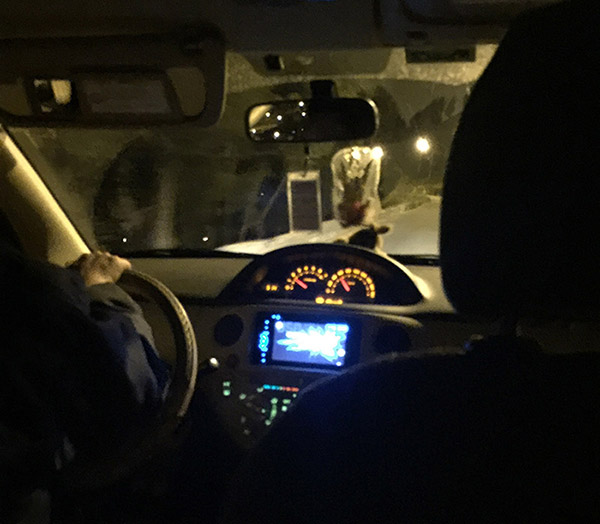
Okey doke.
At El Alto, the gate agent told me to go downstairs and turn right. There is a gate there, she said like she wasn’t 100% sure but somebody had mentioned it once. Downstairs, the sliding doors opened up to the tarmac, with a lonely boarding staircase standing there alone, leading up to an utter lack of a plane. There was absolutely no indication of where we were supposed to go. There were no planes anywhere near us, and the closest plane belonged to Bolivia Air, a different airline.
After a minute, the woman next to me spotted an Amaszonas plane at the far end of the tarmac, so we all walked across the runway, weaving between the baggage handlers and ground crew like we worked there. The only guidance we received upon reaching the plane was a helpful gentleman in an orange vest who told the eagle-eyed woman not to walk into the jet engine right as she was about to do exactly that.
In the flat, desolate mining town of Uyuni I was picked up by Brauliio, a stout Bolivian gentleman with a soft face who owned the tour company that was going to take me out into the Salar de Uyuni salt flats for the day. We got into Brauliio’s hilarious old Jeep thing in the airport parking lot, by which I mean the dirt in front of the airport. It wasn’t actually a Jeep, more the kind of labeless jungle vehicle you’d expect to see in Romancing the Stone or upside down at the bottom of an inaccessible ravine deep in cartel territory.
The Jeep thing had no seat belts, I noticed as we cut a dusty trail through the desert. Brauliio pointed to a metal handle on the dashboard in front of me.
“For security,” he nodded. I held on.
I had a little time to kill in Uyuni before the tour began, which I spent fruitlessly attempting to mail the growing stack of postcards I’d been accumulating from country to country, each country utterly thwarting my efforts to mail them in new and creative ways. (“How does this town not have a post office?” “This is not really a town mister.”)

I realized I needed to duck back into the tour office to collect the postcards from my bag, a key step in being able to mail them. A woman inside asked what I needed and we had a brief, terribly translated conversation in Spanish before I excused myself into the luggage room in the back. Wait, where’s my bag? This room doesn’t look right. Oh shit, I’m in the wrong tour office! Mine is next door. So silly.
I ducked into the next office over, told the woman there I was getting something out of my bag, and scooted into the back room. I don’t remember these bags- Oh goddammit, this isn’t the right office either.
Every office on that street was exactly the same, had a similar sounding name (“Andes Salt Expeditions” “Andean Salt Experience” “Andy’s Salty Empanadas”) and they were all offering tours into the Salar. Christ, I’m going to be here all day. This Groundhog Day loop is my punishment for kicking that squirrel off my balcony, I just know it. I’ve always suspected the squirrels and groundhogs to be in cahoots.
Thankfully the third time was the charm. Either that or I left Bolivia with someone else’s luggage, I don’t know, I haven’t looked at it that closely.

The locals were able to direct me to the area the post office was in, but once I got there I didn’t see anything that looked even remotely like a post office. I pulled it up on Google Maps, which included a handy photo of the front door. It was the door I was standing directly in front of as I was Googling. Okay Bolivia, you win this round.
Walking inside what appeared to be a long-since-closed hotel, I followed a cleaning lady into a room that sort of had counters and might have passed for a post office in an elementary school play, maybe. There was no one there and the room was festooned in what appeared to be Christmas decorations. Where the fuck am I?
The cleaning lady said something to me in Spanish that I took to mean “You’re shit out of luck,” based solely on her tone. Then a helpful young man wandered in of the street and told me the post office was closed. Until when? No one knows. There’s some kind of internal conflict and all the post offices in Bolivia are closed until further notice. Sly move, Bolivia. You win another round, but you still haven’t seen what I did to that bathroom on Isla Del Sol. Let’s call it even.
Waiting back in the tour office. A stray dog wandered in the front door and hung out with us for a while before moseying back out into the street. Cool.
Then suddenly I was loaded, seemingly randomly, into an SUV with a German couple and three young women from Iceland who had just graduated college. We pulled away.
The day tours all have different prices depending on whether you want an English-speaking guide or lunch or airbags. I’d chosen the cheapest option, since I already had read plenty about the Salar and generally have a low opinion of the quality of info you get from tour guides. What I hadn’t considered at all was the practical necessity of being able to understand the guide saying things like “Meet back at the car in 30 minutes” or “Take the wheel I’m going to pee in this Shasta can.”
Thankfully the guy from the German couple spoke great Spanish (all the Germans I met on this trip spoke great Spanish, what the hell is that all about? Maybe Hitler really did escape to Argentina) and he spent the whole day translating everything the guide said for the rest of us.
The tour started in the train graveyard, which was a bunch of old trains abandoned in the desert and not really interesting enough to write about, sorry I already started this sentence so just live with it.


I was more interested in the flat desert that was full of so much trash it seemed like a native species.
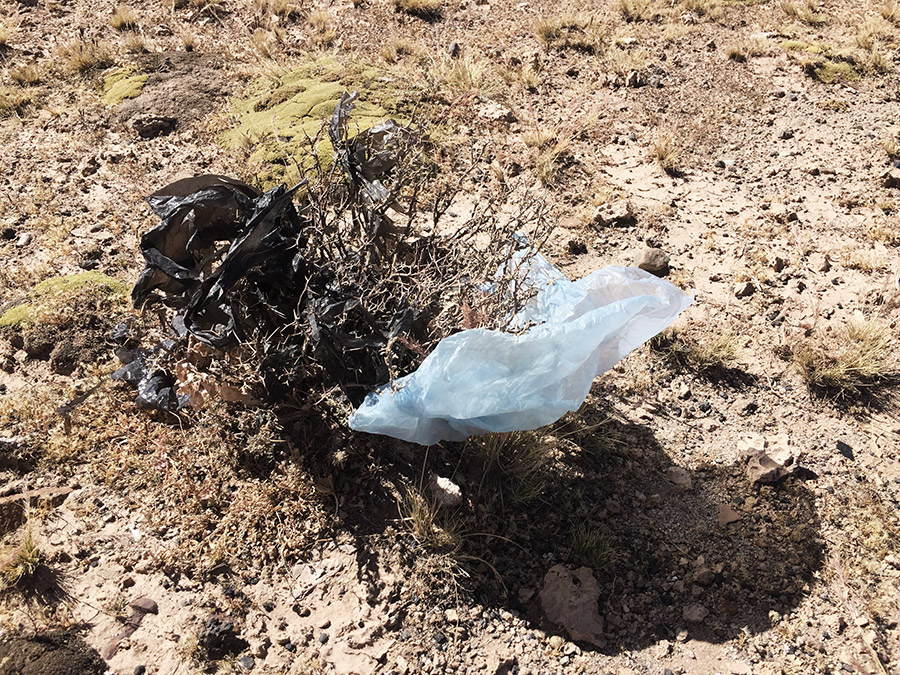
There are really three interesting things in the Salar.
The first are the endless, flat expanses of white salt. When rainwater evaporates in the Salar, it leaves a hexagonal pattern in the salt, and these repeat in an endless honeycomb out across the desert.
These flat expanses are here to make your silly tourist forced perspective photos awesome:


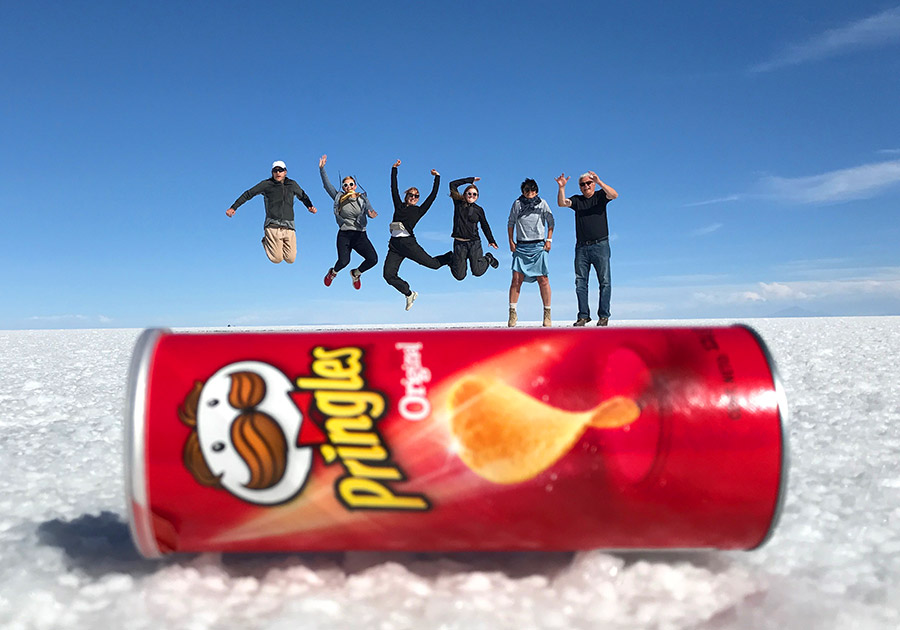

There is a crazy "all kinds of funky homemade vehicles tearing ass across the desert" race held in the Salar every year called Dakar and it’s a big freaking deal. It was heavily advertised at the restaurant we ate lunch at. The restaurant was constructed entirely of salt. The walls, the tables, the floor, everything was salt. How was lunch? Needed salt. Totally not kidding, there was no shaker of salt on the table. Am I above just licking this table? Just barely.

The second interesting things are the small, rocky islands that suddenly rise up out of the Salar. If you’ve seen the end of The Last Jedi, where the goodies make their last stand in that vast white expanse and Luke pulls his “FOOOLED YOU” Spaceballs move on Darth Weenus, it was filmed at one of these islands in the Salar.
We visited a different island, Incahuasi. Aside from being cool and unexpected and covered in cacti, the island also hosts a colony of weird rodents that are stranded on these strange islands, unable to cross the vast empty expanses of salt. I’d heard these creatures described at rats, which really sells short how bizarre they are.
I’d hiked to the peak of the island with the German couple, who then promptly and prudently turned back, as we only had 30 minutes before our ride was leaving. I marveled at the fact that absolutely no one was exploring beyond this point, and started to hike down the other side of the island, navigating the gaps and sudden drops in the razor-sharp rocks.




Before long I’d reached a point where I had to choose between turning back to have any hope of making our departure time, or continuing on to the opposite edge of the island. I reasoned that I could climb down from the far side of the island and run back to the car across the salt much faster than I could climb back up to the peak and then down the other side, so I continued on.
As I got closer to the far side of the island, the terrain became rougher and rougher. Clearly no one had ever hiked here before. I only had five minutes before my ride was leaving, but I was almost to the edge. Then I reached a point where the only option was to climb down into some stark, thorny bushes that formed a barrier on the edge of the island, like Br’er rabbit’s brier patch. I climbed down and instantly sank alarmingly into the bushes up to my waist. Oh shit. Everything was stabbing me on all sides and my shoe was caught in a gap in the rocks. Yeah, this isn’t the kind of thing you can wade through.
Crap. Now I have to climb all the way back up to the peak and run down the other side of the mountain in the next two minutes. I disentangled myself and started to run.
Coming around a corner, I surprised two of the not-rat alien creatures trapped in this biosphere. They looked like tiny kangaroos crossed with chinchillas, and they took off sproing Sproing SPROING like a shot the instant they saw me, disappearing up into crevices in the rock.
Reaching the top I found myself stuck in a conga line of old people very slowly walking down the mountain, and “Perdón, permiso, lo siento”-ed my way down as I weaved and jumped and scrambled my way around people as I heard our driver laying on his horn down in the parking area.
And so, I found myself running down a mountain while a group of people waited and worried for third time on this trip, and the fifth time in the past year. I may have a problem.
The third thing the Salar has to offer is the best of the three. After it rains, the water accumulates a few inches deep on the utterly flat salt plains, forming a perfect mirror reflecting everything above it.
This is great for corny posed photos:


But where the Salar really shines is when the sun sets. My phone photos are complete bullshit compared to what it looked like in real life, and yet the photos are still pretty great:






We stood perfectly still, careful not to create any ripples in the water, for hours as we watched the sun set. It was an utterly disorienting experience because your brain periodically checks in to tell you that you can’t possibly be seeing what you’re seeing, it can’t be real. It looks like a fractal or a rorchacht test or the afterlife. Whatever it was, it quickly climbed up into the list of my favorite things I’ve ever seen.

Checking in for my flight from Uyuni back to La Paz, I was proud of getting through my first substantive interaction entirely in Spanish without having to play the “DUUUUR, ENGLISH?” card. Then as I was walking away, the airline agent pointed to the left and fired off a long salvo in Spanish way too fast for me to have any hope of understanding. I figured she was just pointing me to where the gates were and wishing me a happy Veintiundo de Avril or something, so I nodded okay and hoped the expression on my face hadn’t betrayed my papel higienico thin grasp of the Spanish language.
After waiting through a long line to get to the security checkpoint (no scanners, just a Bolivian guy pulling all of your shit out of your bag and announcing each item to the room, like “Erectile dysfunction pills. Giant purple dildo. Cat Fancy magazine.”) I was unceremoniously rejected and sent back into the other room to pay some made up bullshit “airport tax” before getting back in line again. Ahh, so that’s what that machine gun landslide Spanish word salad had been all about.
Landing in La Paz, as I walked into El Alto airport they were playing House of the Rising Sun ominously over the loudspeakers, just like every single time I’ve been in that airport. I asked if they had any Bolivia Newton John and those fuckers didn’t even laugh.
I had seven and a half hours until my next flight to Santiago via Lima, so I treated myself to a $50 nap inside a broom closet in the airport:

When our flight landed in Lima, a bus was waiting to take us to the airport terminal. A few seconds into the ride, something went terribly wrong under the bus, accompanied by a loud scraping sound and sparks visibly pouring out from underneath the bus, lighting up the dark runway. I assumed we’d blown a tire and were riding on a rim, but the driver paid no mind to this at all and kept going. Every member of the ground crew we drove past had the exact same reaction, their eyes popping huge before they pointed to something we couldn’t see under the bus and laughed as they called their friends over to check this shit out. We’re dragging a Terminator under the bus, aren’t we? You can tell me, I’m from the future.
This development was both amusing and ominous, amusing for obvious reasons and ominous since I was pretty sure a bus needs tires for some reason or another, and the ride just kept going on and on like this for ten minutes. Toward the end of the ride, the entire back end of the bus started to drag on the ground. And then we arrived and everyone got off and walked into the terminal like nothing had happened.
I watched the driver walk to the back of the bus, without getting off, look around the seating area, shrug, and then walk back to the front of the bus to start his next round. Whaddayagonna do? Buses be draggin.’